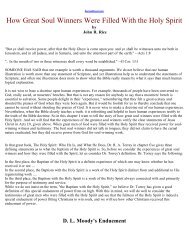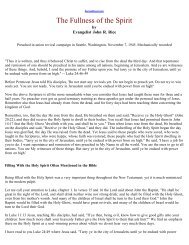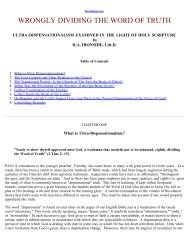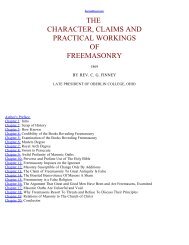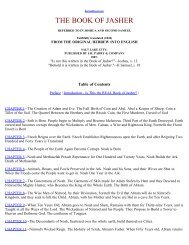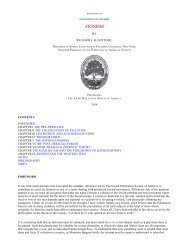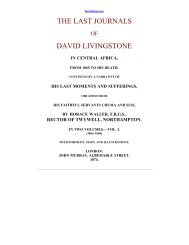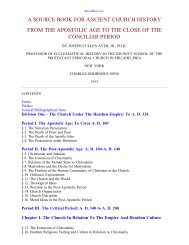Legends of Babylon and Egypt in Relation to Hebrew Tradition.pdf
Legends of Babylon and Egypt in Relation to Hebrew Tradition.pdf
Legends of Babylon and Egypt in Relation to Hebrew Tradition.pdf
Create successful ePaper yourself
Turn your PDF publications into a flip-book with our unique Google optimized e-Paper software.
But even if we regard this suggestion as unproved or improbable, Ezekiel's reference <strong>to</strong> Noah surely presupposes that<br />
at least some version <strong>of</strong> the Flood s<strong>to</strong>ry was familiar <strong>to</strong> the <strong>Hebrew</strong>s before the Captivity. And this conclusion is<br />
confirmed by other <strong>Babylon</strong>ian parallels <strong>in</strong> the early chapters <strong>of</strong> Genesis, <strong>in</strong> which oral tradition rather than<br />
documentary borrow<strong>in</strong>g must have played the lead<strong>in</strong>g part.[1] Thus <strong>Babylon</strong>ian parallels may be cited for many<br />
features <strong>in</strong> the s<strong>to</strong>ry <strong>of</strong> Paradise,[2] though no equivalent <strong>of</strong> the s<strong>to</strong>ry itself has been recovered. In the legend <strong>of</strong> Adapa,<br />
for example, wisdom <strong>and</strong> immortality are the prerogative <strong>of</strong> the gods, <strong>and</strong> the w<strong>in</strong>n<strong>in</strong>g <strong>of</strong> immortality by man is bound<br />
up with eat<strong>in</strong>g the Food <strong>of</strong> Life <strong>and</strong> dr<strong>in</strong>k<strong>in</strong>g the Water <strong>of</strong> Life; here <strong>to</strong>o man is left with the gift <strong>of</strong> wisdom, but<br />
immortality is withheld. And the association <strong>of</strong> w<strong>in</strong>ged guardians with the Sacred Tree <strong>in</strong> <strong>Babylon</strong>ian art is at least<br />
suggestive <strong>of</strong> the Cherubim <strong>and</strong> the Tree <strong>of</strong> Life. The very side <strong>of</strong> Eden has now been identified <strong>in</strong> Southern <strong>Babylon</strong>ia<br />
by means <strong>of</strong> an old boundary-s<strong>to</strong>ne acquired by the British Museum a year or two ago.[3]<br />
[1] See Loisy, /Les mythes babyloniens/, pp. 10 ff., <strong>and</strong> cf. S. Re<strong>in</strong>ach, /Cultes, Mythes et Religions/, t. II, pp. 386 ff.<br />
[2] Cf. especially Sk<strong>in</strong>ner, /Genesis/, pp. 90 ff. For the latest discussion <strong>of</strong> the Serpent <strong>and</strong> the Tree <strong>of</strong> Life, suggested<br />
by Dr. Sk<strong>in</strong>ner's summary <strong>of</strong> the evidence, see Frazer <strong>in</strong> /Essays <strong>and</strong> Studies presented <strong>to</strong> William Ridgeway/ (1913),<br />
pp. 413 ff.<br />
[3] See /<strong>Babylon</strong>ian Boundary S<strong>to</strong>nes <strong>in</strong> the British Museum/ (1912), pp. 76 ff., <strong>and</strong> cf. /Geographical Journal/, Vol.<br />
XL, No. 2 (Aug., 1912), p. 147. For the latest review <strong>of</strong> the evidence relat<strong>in</strong>g <strong>to</strong> the site <strong>of</strong> Paradise, see Boissier, "La<br />
situation du paradis terrestre", <strong>in</strong> /Le Globe/, t. LV, Mémoires (Geneva, 1916).<br />
But I need not now deta<strong>in</strong> you by go<strong>in</strong>g over this familiar ground. Such possible echoes from <strong>Babylon</strong> seem <strong>to</strong> suggest<br />
pre-exilic <strong>in</strong>fluence rather than late borrow<strong>in</strong>g, <strong>and</strong> they surely justify us <strong>in</strong> <strong>in</strong>quir<strong>in</strong>g <strong>to</strong> what periods <strong>of</strong> direct or<br />
<strong>in</strong>direct contact, earlier than the Captivity, the resemblances between <strong>Hebrew</strong> <strong>and</strong> <strong>Babylon</strong>ian ideas may be traced.<br />
One po<strong>in</strong>t, which we may regard as def<strong>in</strong>itely settled by our new material, is that these s<strong>to</strong>ries <strong>of</strong> the Creation <strong>and</strong> <strong>of</strong><br />
the early his<strong>to</strong>ry <strong>of</strong> the world were not <strong>of</strong> Semitic orig<strong>in</strong>. It is no longer possible <strong>to</strong> regard the <strong>Hebrew</strong> <strong>and</strong> <strong>Babylon</strong>ian<br />
Versions as descended from common Semitic orig<strong>in</strong>als. For we have now recovered some <strong>of</strong> those orig<strong>in</strong>als, <strong>and</strong> they<br />
are not Semitic but Sumerian. The question thus resolves itself <strong>in</strong><strong>to</strong> an <strong>in</strong>quiry as <strong>to</strong> periods dur<strong>in</strong>g which the <strong>Hebrew</strong>s<br />
may have come <strong>in</strong><strong>to</strong> direct or <strong>in</strong>direct contact with <strong>Babylon</strong>ia.<br />
There are three pre-exilic periods at which it has been suggested the <strong>Hebrew</strong>s, or the ances<strong>to</strong>rs <strong>of</strong> the race, may have<br />
acquired a knowledge <strong>of</strong> <strong>Babylon</strong>ian traditions. The earliest <strong>of</strong> these is the age <strong>of</strong> the patriarchs, the traditional<br />
ances<strong>to</strong>rs <strong>of</strong> the <strong>Hebrew</strong> nation. The second period is that <strong>of</strong> the settlement <strong>in</strong> Canaan, which we may put from 1200<br />
B.C. <strong>to</strong> the establishment <strong>of</strong> David's k<strong>in</strong>gdom at about 1000 B.C. The third period is that <strong>of</strong> the later Judaean monarch,<br />
from 734 B.C. <strong>to</strong> 586 B.C., the date <strong>of</strong> the fall <strong>of</strong> Jerusalem; <strong>and</strong> <strong>in</strong> this last period there are two reigns <strong>of</strong> special<br />
importance <strong>in</strong> this connexion, those <strong>of</strong> Ahaz (734-720 B.C.) <strong>and</strong> Manasseh (693-638 B.C.).<br />
With regard <strong>to</strong> the earliest <strong>of</strong> these periods, those who support the Mosaic authorship <strong>of</strong> the Pentateuch may quite<br />
consistently assume that Abraham heard the legends <strong>in</strong> Ur <strong>of</strong> the Chaldees. And a simple retention <strong>of</strong> the traditional<br />
view seems <strong>to</strong> me a far preferable attitude <strong>to</strong> any elaborate attempt at rationaliz<strong>in</strong>g it. It is admitted that Arabia was the<br />
cradle <strong>of</strong> the Semitic race; <strong>and</strong> the most natural l<strong>in</strong>e <strong>of</strong> advance from Arabia <strong>to</strong> Aram <strong>and</strong> thence <strong>to</strong> Palest<strong>in</strong>e would be<br />
up the Euphrates Valley. Some writers therefore assume that nomad tribes, personified <strong>in</strong> the traditional figure <strong>of</strong><br />
Abraham, may have camped for a time <strong>in</strong> the neighbourhood <strong>of</strong> Ur <strong>and</strong> <strong>Babylon</strong>; <strong>and</strong> that they may have carried the<br />
<strong>Babylon</strong>ian s<strong>to</strong>ries with them <strong>in</strong> their w<strong>and</strong>er<strong>in</strong>gs, <strong>and</strong> cont<strong>in</strong>ued <strong>to</strong> preserve them dur<strong>in</strong>g their long subsequent his<strong>to</strong>ry.<br />
But, even grant<strong>in</strong>g that such nomads would have taken any <strong>in</strong>terest <strong>in</strong> traditions <strong>of</strong> settled folk, this view hardly<br />
commends itself. For s<strong>to</strong>ries received from foreign sources become more <strong>and</strong> more transformed <strong>in</strong> the course <strong>of</strong><br />
centuries.[1] The vivid <strong>Babylon</strong>ian colour<strong>in</strong>g <strong>of</strong> the Genesis narratives cannot be reconciled with this explanation <strong>of</strong><br />
their source.<br />
[1] This objection would not <strong>of</strong> course apply <strong>to</strong> M. Naville's suggested solution, that cuneiform tablets formed the<br />
medium <strong>of</strong> transmission. But its author himself adds that he does not deny its conjectural character; see /The Text <strong>of</strong><br />
the Old Testament/ (Schweich Lectures, 1915), p. 32.<br />
A far greater number <strong>of</strong> writers hold that it was after their arrival <strong>in</strong> Palest<strong>in</strong>e that the <strong>Hebrew</strong> patriarchs came <strong>in</strong><strong>to</strong><br />
contact with <strong>Babylon</strong>ian culture. It is true that from an early period Syria was the scene <strong>of</strong> <strong>Babylon</strong>ian <strong>in</strong>vasions, <strong>and</strong>



